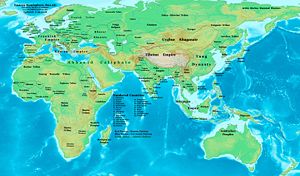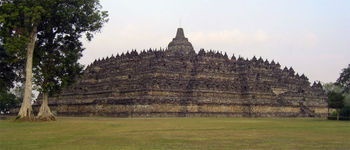8th century
2008/9 Schools Wikipedia Selection. Related subjects: General history
| Millennium: | 1st millennium |
|---|---|
| Centuries: | 7th century · 8th century · 9th century |
| Decades: | 700s 710s 720s 730s 740s 750s 760s 770s 780s 790s |
| Categories: | Births – Deaths Establishments – Disestablishments |
The 8th century is the period from 701 to 800 in accordance with the Julian calendar in the Christian Era.
Overview
During this century the Middle East, the coast of North Africa and the Iberian Peninsula comes rapidly under Islamic Arab domination. The westward expansion of the Arab Empire is famously halted at the Battle of Tours. The tide of Arab conquest came to an end in the middle of the 8th century. Late in the century the Vikings, seafaring peoples from Scandinavia begin raiding the coasts of Europe and the Mediterranean creating a terrifying legacy. They go on to found several important kingdoms.
Events
- Probably at some time in this century, Beowulf is composed.
- The first Serbian state is formed at the beginning of the century.
- Borobodur, the famous Indonesian Buddhist structure, begins construction, probably as a non-Buddhist shrine.
- Buddhist Jataka stories are translated into Syriac and Arabic as Kalilag and Damnag.
- An account of Buddha's life is translated into Greek by Saint John of Damascus, and widely circulated to Christians as the story of Barlaam and Josaphat.
- The Moravian principality and the Principality of Nitra arise in central Europe (see Great Moravia)

The Leshan Giant Buddha of Sichuan province, China; construction began in 713, completed in 803.
- Many Volga Bulgarians convert to Islam.
- Kanem-Bornu arises north of Lake Chad.
- Height of the Classic period in pre-Columbian Maya civilization history.
- Śāntideva, a Buddhist monk at Nalanda Monastery in India, composes the famous Bodhicharyāvatāra, or Guide to the Bodhisattva's Way of Life
- The height of the Giant Wild Goose Pagoda in Xian, China is extended by 5 stories.
- 701, the Taihō Code is enacted in late Asuka period Japan
- 705, the reign of China's first and only sole-ruling empress, Wu Zetian, ends in this year
- 708 - 711, Arab armies occupied Sindh.
- 710, Empress Gemmei moves the capital to Heijō-kyū (present day Nara), initiating the Nara period of Japan.
- 711, Tariq ibn-Ziyad crosses the Straits of Gibraltar. With the creation of Al-Andalus, most of the Iberian peninsula is conquered by Arab and Berber Muslims, thus ending the Visigothic rule, and starting almost eight centuries of Muslim presence there.
- 732, Battle of Tours. Near Poitiers, France, leader of the Franks Charles Martel and his men, defeat a large army of Moors under the governor of Cordoba, Abdul Rahman Al Ghafiqi, who is killed during the battle. The Battle of Tours halts the advance of Islam into Western Europe and establishes a balance of power between Western Europe, Islam and the Byzantine Empire.
- 742, for the municipal census of the Tang Dynasty Chinese capital city Chang'an and its metropolitan area of Jingzhou Fu (including small towns in the vicinity), the New Book of Tang records that in this year there were 362,921 registered families with 1,960,188 persons.
- 748, the Chinese Buddhist monk Jian Zhen writes in his Yue Jue Shu of the international sea traffic coming to Guangzhou, ships from Borneo, Persia, Sri Lanka, Indonesia, and others bringing tons of goods.
- 750, The last Umayyad Caliph Marwan II ( 744–750) is overthrown and executed by the first Abbasid Caliph, Abu al-Abbas al-Saffah. The Caliphate is moved to Baghdad, within the territory of the former Persian Empire; this would prove to be a momentous event for Baghdad which developed into a centre of trade and culture.The Ghana Empire begins.
- 751, Arabian armies defeated Chinese Tang Dynasty troops in the Battle of Talas, in the high Pamirs near Samarkand and conquest central Asia completely.
- 755– 763, the An Shi Rebellion devastates China during the mid Tang Dynasty.
- 758, Arab and Persian pirates and travelers burn and loot the Chinese city of Guangzhou, while the Tang Dynasty authorities shut the port down for the next five decades.
- 772– 804, Charlemagne invades what is now northwestern Germany, battling the Saxons for more than thirty years and finally crushing their rebellion, incorporating Saxony into the Frankish Empire and the Christian world
- 785, beginning in this year, Tang Dynasty Chinese begin landing regular maritime missions on the coast of East Africa, cutting out middlemen Arab sea merchants.
- 785– 805, writing between these years, the Chinese geographer Jia Dan describes large lighthouse pillars built in the Persian Gulf, which is confirmed a century later by al-Mas'udi and al-Muqaddasi
- 793, the very first Viking raid is carried out on the abbey of Lindisfarne in northern England.
- 794, Emperor Kammu moves the capital to Heian-kyō (present day Kyoto), initiating the Heian period of Japan.
- 800,Begins the ancient west African state of Takrur or Tekrour, which flourished roughly parallel to the Ghana Empire.
Significant persons
- Jia Dan, Chinese scholar-official, cartographer, and geographer
- Charles Martel, Frankish leader until 741 (Battle of Tours, 732)
- Pippin the Younger, king of the Franks until 768
- Charlemagne, king of the Franks from 771 to 814
- Alcuin, English monk, scholar, and teacher; Charlemagne's advisor in educational affairs
- The Venerable Bede, English scholar
- Harun al-Rashid, fifth Abbasid Caliph
- Li Po, Chinese poet
- Du Fu, Chinese poet
- Han Gan, Chinese painter
- Empress Gemmei
- Emperor Kammu
- An Lushan
- Muhammad bin Qasim, Arab general who conquered Sindh and Punjab.
Inventions, discoveries, introductions
- heavy plow in use in the Rhine valley
- horse collar in use in Northern Europe in 8th or 9th century — perhaps introduced from Asia
- papermaking introduced from China to Arabs
- beginning of the decline of the Classical Maya civilization
- ca. 770 — iron horseshoes come into common use
- Pattadakal, Chalukya Architecture
- The Chinese Buddhist monk Yi Xing applies the first known clockwork escapement mechanism to operate and rotate his astronomical celestial globe
- The Pictish peoples of Scotland design the first European triangular harp
Decades and years
|
|||||||||||||||||||||||||||||||||||||||||||||||||||||||||||||||||||||||||||||||||||||||||||||||||||||||||||||||||||||||||||||||||||||||||
|
|||||||||||||||||||||||||||||||||||||||||||||||||||||||||||||||||||||||||||||||||||||||||||||||||||||||||||||||||||||


